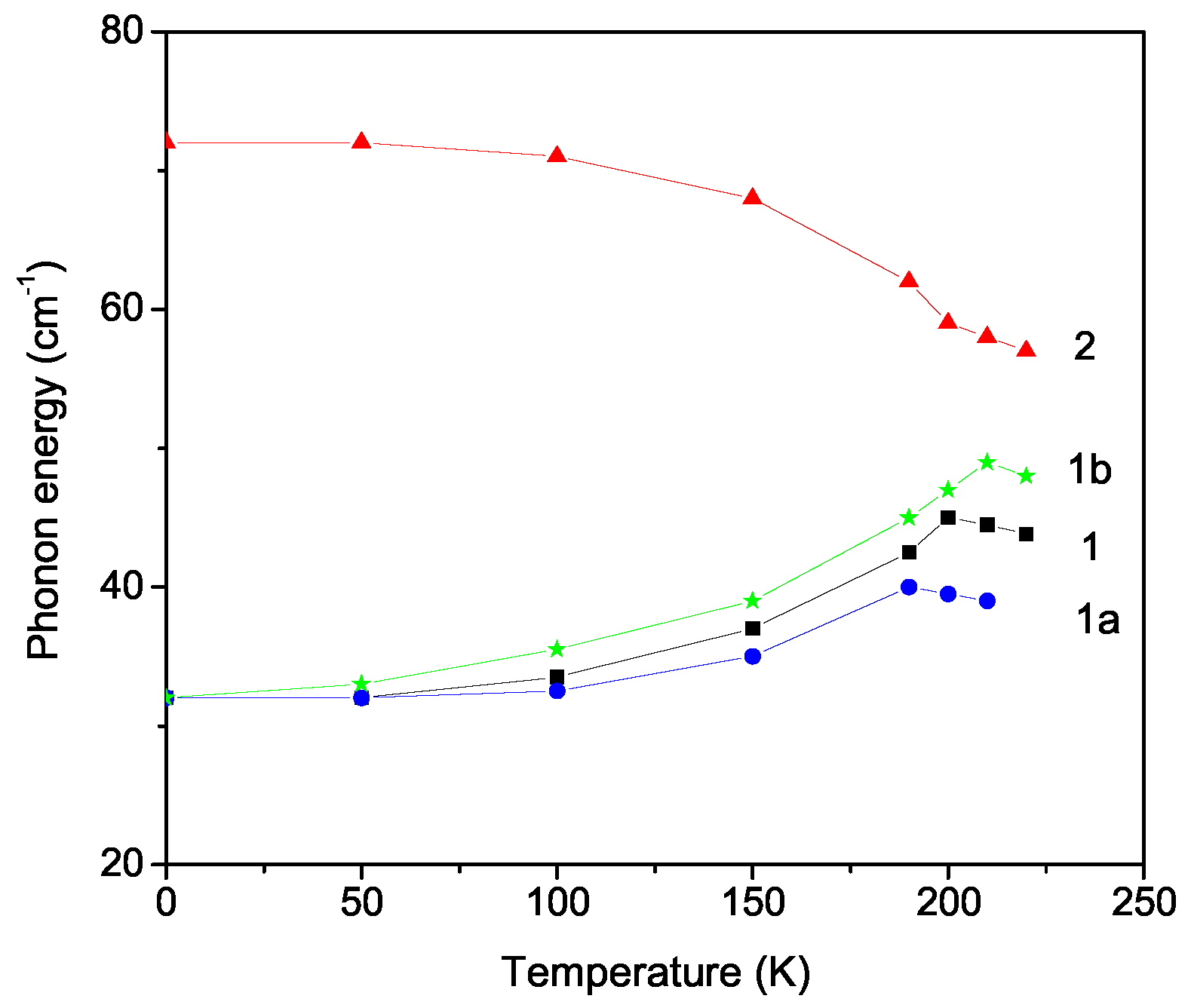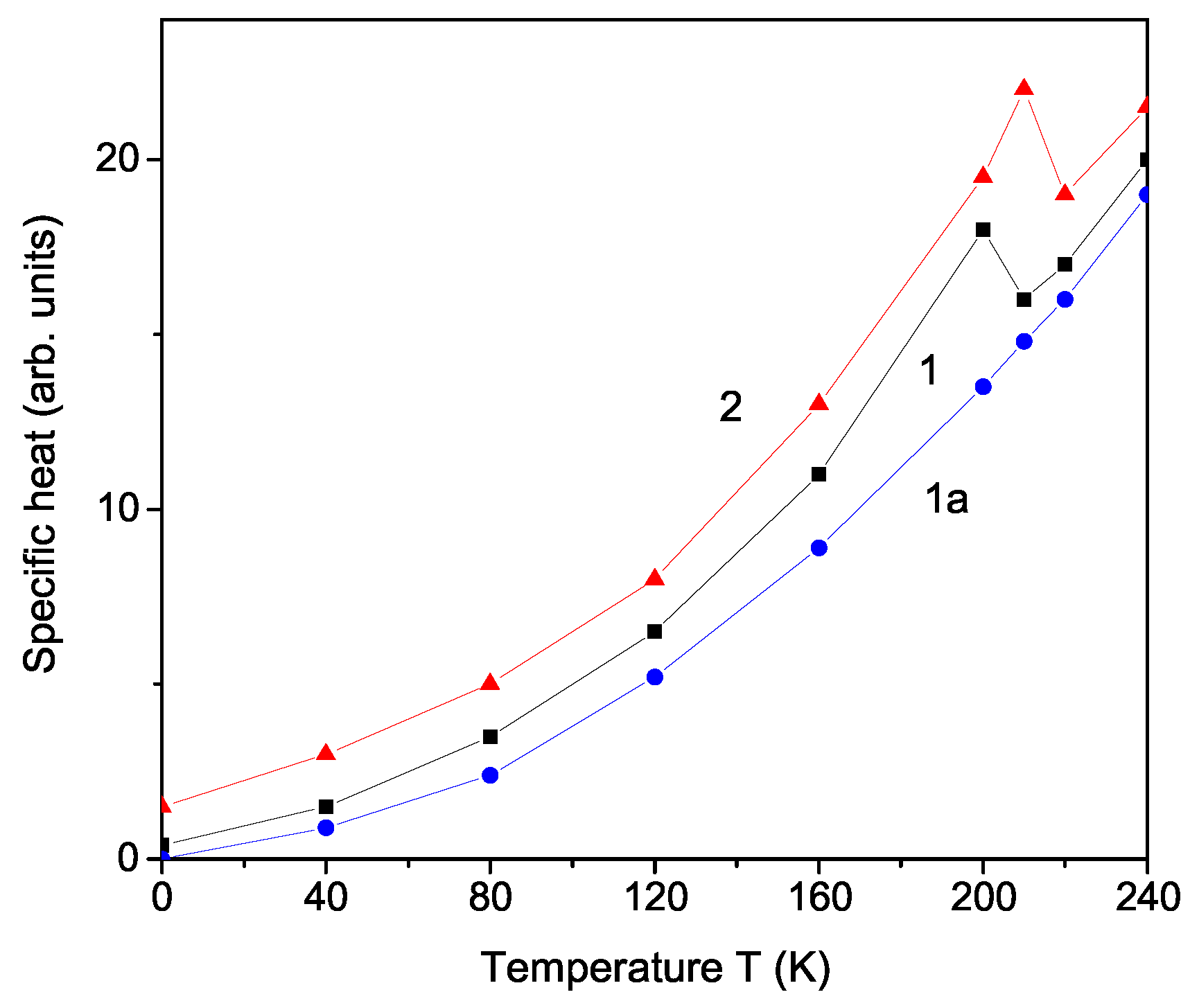Theoretical Study of the Phonon Energy and Specific Heat of Ion-Doped LiCsSO4—Bulk and Nanoparticles
Abstract
:1. Introduction
2. Model and Method
3. Numerical Results and Discussion
3.1. Temperature Dependence of the A1g Phonon Modes = 32 and 72 cm−1 in Bulk LCS
3.2. Temperature and Size Dependence of the Damping of the A1g Phonon Modes = 32 and 72 cm−1 in Bulk LCS
3.3. Size Dependence of the Ferroelastic Phase Transition Temperature
3.4. Temperature Dependence of the Specific Heat in Bulk LCS
3.5. Ion Doping Dependence of the Phase Transition Temperature and the Specific Heat
4. Conclusions
Author Contributions
Funding
Institutional Review Board Statement
Informed Consent Statement
Data Availability Statement
Conflicts of Interest
References
- Salje, E.K.H. Ferroelastic Materials. Annu. Rev. Mater. Res. 2012, 42, 265. [Google Scholar] [CrossRef]
- Hidaka, T. Isotope effects on structural phase transitions in several sulfates. Phys. Rev. B 1992, 45, 440. [Google Scholar] [CrossRef] [PubMed]
- Asahi, T.; Hasebe, K. X-Ray Study of LiCsSO4 in Connection with Its Ferroelastic Phase Transition. J. Phys. Soc. Jpn. 1988, 57, 4184. [Google Scholar] [CrossRef]
- Melo, F.E.A.; Saip, J.A.B.; Guedes, I.; Freire, P.T.C.; Mendes-Filho, J.; Chaces, A.S. Inhibition of the phase transition in CsLiSO4 induced by uniaxial pressure. Ferroelectrics 1999, 233, 57. [Google Scholar] [CrossRef]
- Niwata, A.; Itoh, K. Structural Study of Ferroelastic CsLiSO4 in the High-Temperature Phase. J. Phys. Soc. Jpn. 1995, 64, 4733. [Google Scholar] [CrossRef]
- Lehmann-Szweykowska, A.; Wojciechowski, R.J.; Kurzynski, M.; Wiesner, M.; Mroz, B. Soliton theory of incommensurate phases in LiCsSO4 crystals. J. Phys. Conf. Ser. 2010, 213, 012034. [Google Scholar] [CrossRef]
- Lehmann-Szweykowska, A.; Kurzynski, M.; Wojciechowski, R.; Wiesner, M.; Mroz, B. Anomalous Phase Transitions in LiCsSO4 in the Compressible hcp Ising Model. Acta Phys. Pol. A 2012, 121, 1108–1110. [Google Scholar] [CrossRef]
- Lukyanchuk, I.; Jorio, A.; Pimenta, M.A. Basal-plane incommensurate phases in hexagonal-close-packed structures. Phys. Rev. B 1998, 57, 5086. [Google Scholar] [CrossRef]
- Hoang, D.-T.; Diep, H.T. Hexagonal-Close-Packed Lattice: Phase Transition and Spin Transport. arXiv 2011, arXiv:1112.5724v1. [Google Scholar]
- Arnalds, U.B.; Chico, J.; Stopfel, H.; Kapaklis, V.; Baerenbold, O.; Verschuuren, M.A.; Wolff, U.; Neu, V.; Bergman, A.; Hjoervarsson, B. A new look on the two-dimensional Ising model: Thermal artificial spins. New J. Phys. 2016, 18, 023008. [Google Scholar] [CrossRef]
- Hasebe, K.; Asahi, T. Phenomenological Theory of the Ferroelastic Phase Transitionin LiCsSO4. J. Phys. Soc. Jpn. 1991, 60, 4199. [Google Scholar] [CrossRef]
- Zhou, G.; Bai, X.; Wei, Y.; Guo, M. Ferroelastic phase transition of LiCsSO4 crystal. Ferroelectrics 2016, 502, 221. [Google Scholar] [CrossRef]
- Tuszynski, J.A.; Mroz, B.; Kiefte, H.; Clouter, M.J. Comments on the hysteresis loop in ferroelastic LiCsSO4. Ferroelectrics 1988, 77, 111. [Google Scholar] [CrossRef]
- Shashikala, M.N.; Chandrabhas, N.; Jayaram, K.; Jayaraman, A.; Sood, A.K. High pressure Raman spectroscopic study of LiCsSO4: Pressure induced phase transitions and amorphization. J. Phys. Chem. Solids 1994, 55, 107. [Google Scholar] [CrossRef]
- Lemos, V.; Silveir, E.S.; Melo, F.E.A.; Ilho, J.M.; Pereir, J.R. Raman study of LiCsSO4. Phys. Status Solidi B 1991, 164, 577. [Google Scholar] [CrossRef]
- Morell, G.; Devanarayanan, S.; Katiyar, R.S. Temperature-dependent Raman scattering studies in ferroelastic LiCsSO4. J. Raman Spectr. 1991, 22, 529. [Google Scholar] [CrossRef]
- Kaczmarski, M.; Wiesner, M. Temperature-dependent low wavenumber Raman scattering studies in LiCsSO4 crystal. J. Raman Spectr. 2010, 41, 1765. [Google Scholar] [CrossRef]
- Trzaskowska, A.; Mielcarek, S.; Mroz, B. Behaviour of surface phonons in LiCsSO4 crystal at phase transition. Cryst. Res. Technol. 2005, 40, 449. [Google Scholar] [CrossRef]
- Trzaskowska, A.; Mielcarek, S.; Mroz, B.; Andrews, G.T. Surface Phonons and Soft Bulk Modes in LiCsSO4 Crystals Studied by the High Resolution Brillouin Scattering. Ferroelectrics 2008, 363, 168. [Google Scholar] [CrossRef]
- Milinskiy, A.Y.; Baryshnikov, S.V.; Charnaya, E.V.; Nguyen, H.T. Size effects in the ferroelastic LiCsSO4. Ferroelectrics 2019, 543, 12. [Google Scholar] [CrossRef]
- Borisov, B.F.; Charnaya, E.V.; Baryshnikov, S.V.; Pirozerskii, A.L.; Bugaevd, A.S.; Tien, C.; Lee, M.K.; Michel, D. Ferroelastic phase transition in LiCsSO4 embedded into molecular sieves. Phys. Lett. A 2010, 375, 183. [Google Scholar] [CrossRef]
- Czaja, P. Detection of a ferroelastic phase transition in Csx(NH4)1-xLiSO4 with the use of the DSC method. J. Therm. Anal. Calorim. 2013, 113, 91. [Google Scholar] [CrossRef]
- Zapart, M.B.; Zapart, W.; Czaja, P.; Mila, T.; Solecki, J. EPR Spectroscopy and Ferroelastic Domain Structure in the LiRbSO4-LiCsSO4 System. Ferroelectrics 2011, 417, 70. [Google Scholar] [CrossRef]
- Lima, R.J.C.; Freire, P.T.C.; Sasaki, J.M.; Ayala, A.P.; Melo, F.E.A.; Filho, J.M.; Hernandes, A.C. Temperature-dependent Raman scattering studies in CsLiSO4 and RbxCs1–xLiSO4 (x = 0.35). J. Raman Spectr. 2001, 32, 1046–1051. [Google Scholar] [CrossRef]
- Misra, S.K.; Misiak, J.E. Electron-paramagnetic-resonance study of Cu2- and Mn2+-doped LiCsSO4 single crystals: LiCsSO4 phase transitions. Phys. Rev. B 1993, 48, 13579. [Google Scholar] [CrossRef] [PubMed]
- Tserkovnikov, Y.A. Decoupling of chains of equations for two-time Green’s functions. Teor. Mat. Fiz. 1971, 7, 511. [Google Scholar] [CrossRef]
- Wesselinowa, J.M.; Apostolov, A.T. Anharmonic effects in ferromagnetic semiconductors. J. Phys. Condens. Matter 1996, 8, 473. [Google Scholar] [CrossRef]
- Golosovsky, I.V.; Mirebeau, I.; Andre, G.; Kurdyukov, D.A.; Kumzerov, Y.A.; Vakhrushev, S.B. Magnetic Ordering and Phase Transition in MnO Embedded in a Porous Glass. Phys. Rev. Lett. 2001, 86, 5783. [Google Scholar] [CrossRef] [PubMed]
- Wesselinowa, J.M. Size and anisotropy effects on magnetic properties of antiferromagnetic nanoparticles. J. Magn. Magn. Mater. 2010, 322, 234–237. [Google Scholar] [CrossRef]
- Delfino, M.; Loiacono, G.M.; Smith, W.A.; Shaulov, A.; Tsuo, Y.H.; Bells, M.I. Thermal and dielectric properties of LiKSO4 and LiCsSO4. J. Solid State Chem. 1980, 31, 131. [Google Scholar] [CrossRef]
- Polomska, M.; Wolak, J.; Szczesniak, L. High temperature phase transition of β-LiNH4SO4 single crystal. Ferroelectrics 1994, 159, 179. [Google Scholar] [CrossRef]
- Kassem, M.E.; El-Wahidy, E.F.; Kandil, S.H.; El-Gamal, M.A. Thermal anomaly in LiKSO4 crystals in the temperature range 300–800 K. J. Therm. Anal. 1984, 29, 325. [Google Scholar] [CrossRef]
- Yurtseven, H.; Tirpanci, D.V.; Karacali, H. Analysis of the Specific Heat of Ru Doped LiKSO4 Close to Phase Transitions. High Temp. 2018, 56, 462. [Google Scholar] [CrossRef]
- Kassem, M.E.; El-Muraikhi, M.; AL-Houthy, L.; Mohamed, A.A. Dielectric dispersion in pure and doped lithium rubidium sulphate. Radiat. Eff. Defects Solids 1996, 138, 285. [Google Scholar] [CrossRef]
- Kassem, M.E.; El-Muraikhi, M.; Al-Houty, L.; Mohamed, A. A Specific heat of pure and doped LiRbSO4 crystals. Thermochim. Acta 1992, 206, 107. [Google Scholar] [CrossRef]
- Choi, J.H.; Kim, N.H.; Lim, A.R. Nucleus-phonon interactions of MCsSO4 (M = Na, K, or Rb) single crystals studied using spin–lattice relaxation time. J. Korean Magn. Res. Soc. 2014, 18, 15. [Google Scholar] [CrossRef]





Disclaimer/Publisher’s Note: The statements, opinions and data contained in all publications are solely those of the individual author(s) and contributor(s) and not of MDPI and/or the editor(s). MDPI and/or the editor(s) disclaim responsibility for any injury to people or property resulting from any ideas, methods, instructions or products referred to in the content. |
© 2024 by the authors. Licensee MDPI, Basel, Switzerland. This article is an open access article distributed under the terms and conditions of the Creative Commons Attribution (CC BY) license (https://creativecommons.org/licenses/by/4.0/).
Share and Cite
Apostolov, A.T.; Apostolova, I.N.; Wesselinowa, J.M. Theoretical Study of the Phonon Energy and Specific Heat of Ion-Doped LiCsSO4—Bulk and Nanoparticles. Materials 2024, 17, 2845. https://doi.org/10.3390/ma17122845
Apostolov AT, Apostolova IN, Wesselinowa JM. Theoretical Study of the Phonon Energy and Specific Heat of Ion-Doped LiCsSO4—Bulk and Nanoparticles. Materials. 2024; 17(12):2845. https://doi.org/10.3390/ma17122845
Chicago/Turabian StyleApostolov, Angel T., Iliana N. Apostolova, and Julia Mihailowa Wesselinowa. 2024. "Theoretical Study of the Phonon Energy and Specific Heat of Ion-Doped LiCsSO4—Bulk and Nanoparticles" Materials 17, no. 12: 2845. https://doi.org/10.3390/ma17122845




